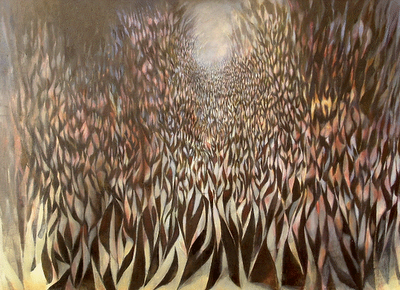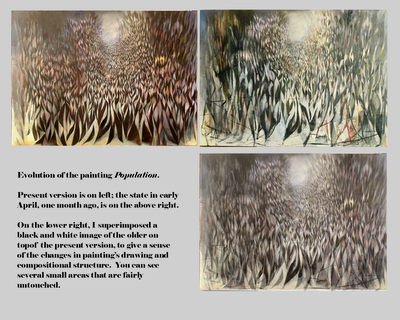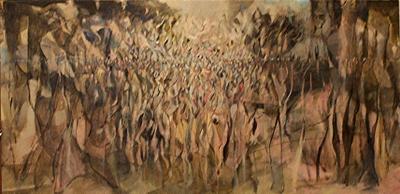Friday, June 05, 2009
Saturday, June 28, 2008
A Dark Passage
 (Click on the image to enlarge)
(Click on the image to enlarge) A canvas that I started working way back in 2001, this did not really begin to develop until last year, when I drove toward a strong classical illusion of light and dark, but only in service of mood. This image is wholly invented, and is to me a logical extension of abstract expressionist techniques. I simply kept driving until a landscape slowly emerge, populated with Arshile Gorky-like figurative lines stuffed back into specific allocations of space. The color and light in the impossible sky (no moonlight and sunrise would work like this) is verging dangerously on the surreal, but I'm not exploring a subconscious dream-image world, or front-loading an image with a sense of the internal purity of the subconscious.
I hope that the mood emerges naturally; if there is any specific referent (and this is a recurrent theme) it is that in the midst of the contemplation of emptiness, it is impossible not to want to see people, but our experience of this, while emotionally strong, is visually fleeting, always in motion, always just beyond grasp.
Are the swirling lines and forms sinking into and out of the dark gendered? Yes - you can think of a Picasso line, it's weight turning and twisting and surprisingly sexualized even while dissociated from body-but this is one way somewhat incidental to the work of the painting. Virtually all the work was the invention of the space, light and landscape. But I do think that the implication of imagined figures and imagined place is balanced on viewing the piece.
Saturday, February 23, 2008
The Everything Painting

Click on Image to Enlarge
This still-untitled work is in oil, about 60" by 84", and began with my most traditional process of two or three sessions with a model. Like the last major painting, there is a distinct implication of perspectival and atmospheric distance that the figurative forms occupy. Here, the connection to a real person, and a much more specifically conceived invented landscape are more apparent.
I am flirting with surrealism here, not to mention eroticism, but these evolved out of working with it. To me, it's closest affinity is with Excavation, by DeKooning. It has the same figurative sources, the same push to all-over abstracted form tiling, but re-embraces classical painting spatiality.
Which may be why these are taking so long - I have to decide where every abstract bit hangs in space, without much of a mimetic guide other than skin in light and shadow, and there almost no sketches. It was worked like a high modernism - trial and error, excavating the form.
The model's relationship to the image grew particularly stretched in terms of imagery, but her compositional positions were critical and largely survived. I have several earlier versions I may post later.
This working title of "The Everything Painting" is due to it's somewhat hopeless attempt to find a sweet spot between figurative realism, all-over abstraction, classical landscape (there is an ocean and a ground and a distant mountain range under there) and I'm afraid to say surrealism, in the sense at least of dream imagery. I generally dislike surrealism, with the exception of Yves Tanguy, because it tends to feel false and forced to me.
What I do like is any painting that successfully creates an embracing idea-atmosphere, where the emotions and the logic of the work are inseparable, powerful, and specific to the terms of painting.
Julianna in the Near Final Version
 Click on image to enlarge
Click on image to enlargeThis is the near final version of Julianna, o/c 60" by 42", originally posted below.
Sorry for the image quality -to be improved on most of these soon.
Moving to Private Collection
Anchorage, Alaska
Anchorage, Alaska
A Ferocious Collage - Island in Water, Island of Water

This is a medium size collage made from about 125 landscape paintings, intent on wrapping the horizon line around, which creates an atmospheric and perspectival infinity all around the edges, and in the middle.
Might turn into a major painting.
Thursday, November 08, 2007
Jamie Bollenbach Main Website
I'm building a new web site here, which features the work using slide show software, as well as links to my teaching syllabi, professional and contact information, and a 2004 interview.
Thursday, November 01, 2007
Jamie Bollenbach at MyArtSpace
Many of these works and some others are located in web gallery format here.
Friday, June 01, 2007
New Work, in Progress

(Click for larger image.)
This largish piece (about 60" by 48" currently untitled) has been consuming me for some months - it's an older work I've repainted innumerable times since it was begun in late 2005. The original subject is a model named Julianna, who posed for about three sessions at that time. No photos, video or digital manipulations were used.
The problem here lurks under the surface of all my post-2002 work: how do a series of related images occupy the same space without simply being juxtaposed? I'm trying to integrate the paint marks - which can indicate space or light on, behind, next to or in front of my memory of the model, with each other, getting them to flow naturally into one another - the effect is somewhat pointillistic, but the issue is not accurate light and color, but rather the inconsistent way light and color on the figure are both preserved and distorted by memory.
A loose, more or less modernist aesthetic interpretation governs most of the day to day painting choices.
Sunday, May 07, 2006
Population
 Population, oil on canvas aprox. 37" by 50". (c) 2006 Jamie Bollenbach All rights reserved.
Population, oil on canvas aprox. 37" by 50". (c) 2006 Jamie Bollenbach All rights reserved.This is two or three months of difficult work, done very inefficiently, without planning sketches: a technical summary of the last four years, either the beginning or end of something. Horror vacui if ever there was - but the operational idea is simply spatial shapes transforming into shapes with figurative referents. There is a lot of deep space and compositional movements across the collections of shapes. With no model, it's somewhat emotionless in execution, although it should be unsettling in terms of where the viewer is, and whether the subject really has anything to do with a person, or a landscape. Primarily, it pushes the evolution of these marks into the horizon, into darkness, into grey space until they disappear. The vision's desire to resolve these into people keeps the eye moving, scanning, so that it is difficult to see the piece as a single image. That means the image must be "read" over a period of time rather than recognized as a solitary symbol.
I'm interested in the way a painting can specifically portray time by direct manipulation of images, and surface properties, which imply time, and relate to the passage of time in the making of the image itself: the strange balance of paintings, particularly portraiture, that photograhy or paintings of photography tend to lack.
Influential to this was a desire to do the equivalent of treating a Willem DeKooning in three dimensions, with something like real light (but without a distinct source.) Related work, but not directly influential, is with early Marcel Duchamp, the Futurists, cubism (well, that covers both the fascists and the communists) in the attempt to tackle time, and surrealist Yves Tanguy with precise surface qualities of unreal objects: an objective treatment of the non-objective.
Collection of the Artist. Available.
Friday, April 14, 2006
Comparisons
 Working Title: Population
Working Title: Population2006, o/c
This my primary working painting for the last two months, still in process. It has only grown more and more complex, absorbing each mark and demanding reactions. I'm thinking of it as something like a Excavation by Dekooning, but treated in classical dimensions. (It has also been described lightly as Nude Descending a Hell of a Lot of Staircases. )
This painting is the end of a certain composition I have used for a while, and I suspect the beginning of a substantial shift in my work.
It has changed substantially in the last two weeks, particularly in the lower third, and on the upper left; the distant center, detail below, has changed somewhat less.

Sara #27 2005 o/c 24" x 40"
 This piece was sourced directly from a set of poses by Sara, over about 3 sessions in June 2005 - it's dark to allow a great variance in transparency, and to create a strong illusion of piercing lines of light. I particularly like the dimensionality of the fluttering small collection of marks around the primary figure off to the right.
This piece was sourced directly from a set of poses by Sara, over about 3 sessions in June 2005 - it's dark to allow a great variance in transparency, and to create a strong illusion of piercing lines of light. I particularly like the dimensionality of the fluttering small collection of marks around the primary figure off to the right.It's reactive rather than planned; I became more and more interested in making transparent marks - like wholly disconnected areas of highlights hitting skin, flicking around in all directions. This painting was a significant advance, one of my favorites.
Collection of Mark Vadon and Mattie Iverson.
Friday, November 25, 2005
"Birthday"
 "Birthday" 2005
"Birthday" 200528" by 60"
Acrylic on Canvas
This acrylic piece, with it's central spatial compression of the figurative marks, is the direct antecedent of the "Population" painting at top.
This was part of pushing the figurative references to the absolute edge of disappearance, and the landscape reference, as in many of the works in the last two years, is a nearly empty, imaginary space - the light is simply an actor, not a lamp or a sun, or even a specific source.
Collection of Green and Yalowitz, Seattle
Saturday, September 24, 2005
Afterimage: Sara
 Afterimage: Sara
Afterimage: Sara2005
65" by 48" o/c
A 2005 work, just recently reworked significantly (this is the older image), using the same principle of spun off mark from the figure. The model is again Sara Graves - you should be able to suss out the three primary poses.
The view is off my studio in Ballard; the specific details are unresolved to emphasize the complex graphic interaction of the gestural and U- shaped marks spinning around the figure "centers."
There is much greater variation in the opacity and precision of the marks - they are gestural in origin but are more carefully resolved; one way to think of these might be a Dekooning with all the classical rules of painting spatiality back in place.
This painting was begun rather casually, but the complexity of the interaction of the marks nearly overwhelmed me as I worked to complete it. The marks have become both spatial and descriptive, gestural and highly specific. It takes me about half an hour to reaquaint myself with the painting before I can actually work on it.
 Two Before Windows
Two Before Windows 90" by 66" o/c
2002 (reworked 2005)
Exhibited originally at the Henry Art Gallery in Seattle for my 2002 MFA, I refined this painting heavily this summer, completely reworking the face and upper torso, opening new "fissures" of spatial area, and cleaning up the large vertical marks.
This is the only one of my recent painting to include a "complete" figure, with the model's head totally solid; the suggestion is that as as time passed, only her face solidified in the memory, and the shapes of the room and her body spin off exist in a more fluid temporal space.
A lot of my time is spent stitching abstract planes, figurative marks, and observational memory into a believable if non-specific space. I depend on painting tools to form their own rooms and spaces and even people in a kind of response to observed reality, rather than a slavish visual mimesis.
Available.

Pink Marks of Absence
24" by 48" o/c 2001-2005
This is actually my first painting (from graduate school at UW- Seattle ) involving the style of figurative marks in a perspectival space, and was heavily reworked in the last two months. Only small parts of a pink field from the original show through; it was only this year that I recognized the method to complete it.
Available.
 Arctic #2, Oil/panel 24" by 48" 2005
Arctic #2, Oil/panel 24" by 48" 2005Exhibited recently at the Pratt Museum in Alaska, in a tribute exhibition to artist Alex Combs, a pioneer of abstraction and expression in the Last Frontier, a long-time friend of my family whose work contributed to my ambitions as an artist.
The imagined sea-ice surface, and the darks of the ocean, are highly textured and fairly rich, and the figurative marks are reduced to tiny traces.
Collection of the Artist.
Sunday, August 21, 2005

This is an installation style view of an untitled wire and acrylic paint sculpture in fron of Sara #9. The sculpture is about 70" high and fully dimensional.
The relationship between the two is striking- the gestures and colors of the sculpture fold almost seamlessly into the painting, which was something of a surprise to me. as this was not directly planned.
Sara #9 was originally sourced from the observed figure, in this case my friend and frequent model Sara Graves, while the sculpture was my first large scale attempt to build a sculpture as a painting object. (An interview with me on this subject is located at Liquitex.com, who were rather thrilled at the 3-d use of heavy-body acrylic, in large quantities!)
Subscribe to:
Posts
(
Atom
)







